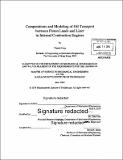| dc.contributor.advisor | Tian Tian. | en_US |
| dc.contributor.author | Fang, Tianshi | en_US |
| dc.contributor.other | Massachusetts Institute of Technology. Department of Mechanical Engineering. | en_US |
| dc.date.accessioned | 2014-12-08T18:51:54Z | |
| dc.date.available | 2014-12-08T18:51:54Z | |
| dc.date.copyright | 2014 | en_US |
| dc.date.issued | 2014 | en_US |
| dc.identifier.uri | http://hdl.handle.net/1721.1/92143 | |
| dc.description | Thesis: S.M., Massachusetts Institute of Technology, Department of Mechanical Engineering, 2014. | en_US |
| dc.description | Cataloged from PDF version of thesis. | en_US |
| dc.description | Includes bibliographical references (pages 135-136). | en_US |
| dc.description.abstract | The consumption of lubricating oil in internal combustion engines is a continuous interest for engine developers and remains to be one of the least understood areas. A better understanding on oil transport is critical to an optimization of engine designs, and advanced analytical tools are essential to the achievement of reduced frictions without compromising oil consumption. Oil transport from piston lands to a liner, hereafter called "bridging", has been observed in engine tests. The additional oil transferred to the liner becomes a potential source of oil consumption through ring-liner interaction. Thus, it is important to develop more quantitative models to better analyze bridging. The objective of this work is to obtain a more in-depth understanding on the oil transport between piston lands and liner and provide quantitative models of the oil transport mechanisms. Multiphase Computational Fluid Dynamics (CFD) was employed together with analyses of experimental observations. Three categories of bridging were identified: assisted bridging, self-sustained bridging, and reverse bridging. While assisted bridging involves an axial oil flow across an entire piston land, the other two phenomena are localized and become prominent at low engine speeds. The mechanisms of each phenomenon were analyzed in this work. Correlations and theoretical models were developed to associate the risk of bridging with geometrical designs of a piston and operating conditions of an engine. Particularly, the theoretical model of self-sustained bridging contributes to the optimization of geometrical designs of the third land of a piston ring pack. This work constitutes a major step towards a further quantification of oil transport. Some findings and models presented in this work can readily contribute to providing optimal solutions to certain piston regions. Furthermore, the results of this work serve broader purposes in providing boundary conditions to other interactions in a piston ring pack. | en_US |
| dc.description.statementofresponsibility | by Tianshi Fang. | en_US |
| dc.format.extent | 136 pages | en_US |
| dc.language.iso | eng | en_US |
| dc.publisher | Massachusetts Institute of Technology | en_US |
| dc.rights | M.I.T. theses are protected by copyright. They may be viewed from this source for any purpose, but reproduction or distribution in any format is prohibited without written permission. See provided URL for inquiries about permission. | en_US |
| dc.rights.uri | http://dspace.mit.edu/handle/1721.1/7582 | en_US |
| dc.subject | Mechanical Engineering. | en_US |
| dc.title | Computations and modeling of oil transport between piston lands and liner in internal combustion engines | en_US |
| dc.type | Thesis | en_US |
| dc.description.degree | S.M. | en_US |
| dc.contributor.department | Massachusetts Institute of Technology. Department of Mechanical Engineering | |
| dc.identifier.oclc | 896413272 | en_US |
